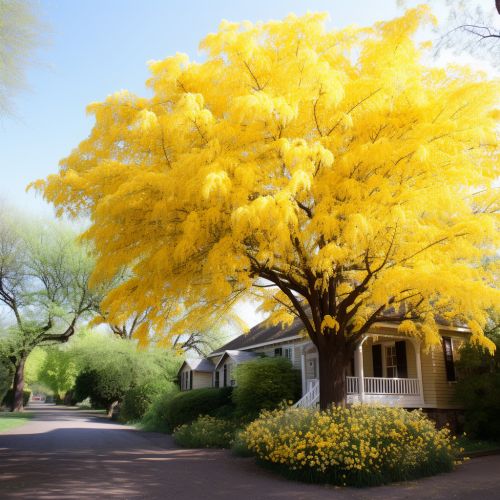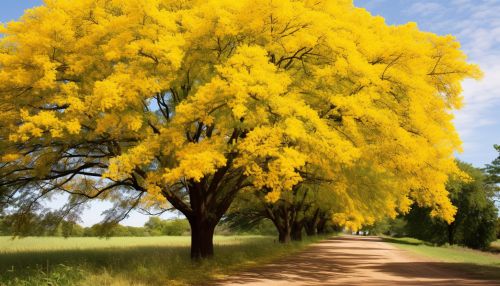Honey Locust
Taxonomy and Description
The Honey Locust (Gleditsia triacanthos), also known as the thorny locust or thorny honeylocust, is a deciduous tree in the Fabaceae family. It is native to central North America where it is mostly found in the moist soil of river valleys. Honey locust is highly adaptable to different environments, has been introduced worldwide, and is an aggressive invasive species in some areas.


The tree is named for its sweet legume pulp, which was used for food by Native American people, and can still be found growing in the wild. The honey locust has a broad, open crown and a short trunk. The tree's bark is gray or light brown with deep furrows and scaly ridges. The tree's mature height is typically 20-30 meters, but can reach up to 50 meters under optimal conditions.
Characteristics
Honey locusts are known for their unique leaf structure. The leaves are pinnately or bipinnately compound on older trees but can be simple on seedlings and young plants. The leaflets are 1.5-2.5 cm (smaller on bipinnate leaves) and bright green. They turn yellow in the fall (autumn) before they fall off. The leaves are arranged alternately on the stem.
The flowers of the honey locust are small, greenish-yellow and fragrant. They are arranged in racemes that can be up to 20 cm long. The flowers are perfect, with both male and female parts, but some trees are male and produce only pollen. The flowers bloom in late spring (May-June).
The fruit of the honey locust is a flat legume (pod) that matures in early autumn. The pods are generally between 15-20 cm in length and are dark brown, almost black at maturity. The pulp of the pod is sweet, greenish-brown and jelly-like. The seeds are oval, dark brown and surrounded by a thick, whitish, sweet pulp.
Ecology
Honey locusts are highly adaptable and can grow in a variety of environmental conditions. They prefer full sun and can tolerate drought conditions. They are often found in both the understory and the canopy layers of forests, and in savannahs, pastures, and roadside or railway embankments.
Honey locusts play a significant role in their ecosystems. The trees' seeds are disseminated by herbivores; the sweet pulp of the pods is an attractant to wildlife, including deer and squirrels. The tree's bark and leaves are also a food source for various insects.
Cultivation and Uses
Honey locusts are popular ornamental trees due to their rapid growth and tolerance of urban conditions. They are also used in forestry for soil improvement and reclamation. The wood of the honey locust is hard and durable, making it useful for furniture, paneling, fencing, and other applications.
The sweet pulp of the honey locust's pods was used by Native American people as a food source and sweetener. Today, it is sometimes used in survival situations as an emergency food source.
Invasive Species
While the honey locust is native to central North America, it has been introduced to other parts of the world, including Europe, Asia, and Australia. In some areas, it has become an invasive species, outcompeting native plants and altering habitats.
